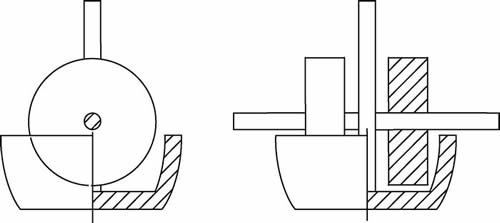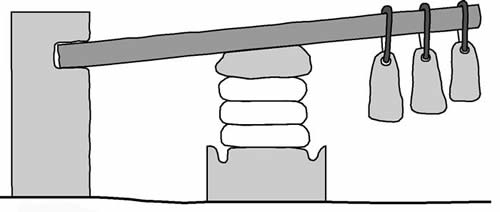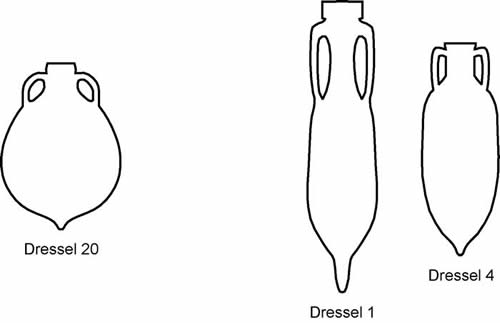Ancient Olive Oil Production: The Roman World, Part II
by Chris Mundigler
In the last few issues of Labyrinth, we’ve looked at the cultivation, production, use and trade of olives and olive oil from the ancient Near East, Egypt, Greece, and finally Rome. As we move from region to region and source out both ancient literary references and modern archaeological evidence, one thing becomes strikingly clear – the best way to cultivate, harvest and process olives was developed by some of the earliest of these cultures. Very little actual improvement in these techniques took place through to the Middle Ages and very little changed in the cultivation and production stages of this commodity, despite Roman propensity for innovation and trade through conquest.The Romans continued to harvest the fruit as it had been done for generations before them farther to the east in the Mediterranean region, and while many of the earlier cultures made use of a bag and beam press arrangement which the Romans continued to use (and which is described in earlier issues of Labyrinth and illustrated farther below in this article), the Romans did improve on the crushing process of the olive fruit which produced the high quality oil so greatly prized. Most of the top-grade oil was now crushed in roller mills, called mola olearia in the Roman world (see illustration below).

Great care was taken to ensure that the cylindrical stones which crushed the olives were set to just the right spacing between them and the mill receptacle that held the olives so that the pulp was separated without crushing the inner nut, which would lend a very bitter taste to the precious oil.
The liquid from the crushing was lead off into a reservoir where the oil was skimmed off the top, leaving behind a low-grade water extracted from the olives. The remaining mash from the crushing process was then pressed even further using a beam press (similar in principle to the one illustrated below) to extract yet another, somewhat inferior, grade of olive oil.

The Romans, being as practical as they were, even put the mash from this secondary pressing to good use – as fertilizing manure for their farms and fields. The olive oil lees, rubbed on the inside of clay transport amphorae, also helped waterproof the very jars in which the olive oil was shipped throughout the Empire.
Once the “fruit of the gods” had been turned into liquid gold, the uses and trade which the Romans extended to olive oil went far beyond that of any previous Empire. There were, of course, the usual cooking and lighting applications for olive oil as in other places and times around the Mediterranean, but the Romans also used it for everything from lubricating their innovative machinery to curing medical ailments, as mosquito repellent and helping with pregnancy, morning sickness and delivery.1
As for the amphorae used in the trade and transport of olive oil, we have archaeological evidence at Mt. Testaccio (on the Tiber River just outside Rome), for example, that tells a very clear story. Mt. Testaccio (Italian for Mt. Potsherd) is a huge hill measuring some 22,000 square metres in size and rising almost 50 metres in height, made up entirely of broken and discarded transport amphorae. These pottery vessels once carried many millions of litres of olive oil into Rome over at least a 250 year period (from the first to the mid-third centuries A.D.) from Spain and north Africa – major producers of olive oil for both Italy and the Empire.
Mt. Testaccio appears to have been the transfer point of imported oil from large shipping amphorae (some with a carrying capacity of as much as 80 litres and weighing 95 kilograms each for the so-called Dressel 20 style) into smaller, more manageable pottery vessels and amphorae of around 25.5 litres (or 48 sextarii in Roman standard measure) – still a substantial amount of oil to be transported around Rome and into the countryside.

These amphorae coming into Rome, its provinces and frontiers, were handled with great efficiency and care. Rather than each individual amphora being loaded and unloaded by hand from ships and carts, groups of vessels – tied with ropes through the handles grape-cluster like – were probably handled by shoremen using Roman treadmill cranes to rival even our own modern lifting machines.
While it’s been suggested that Roman legions each consumed as much as 1370 amphorae of olive oil per year, based on trade and administrative records, most of the oil was used by average people for lighting and cooking. The upper class also enjoyed being oiled and massaged in unctuarium at public and private baths where slaves would rub oil onto their bodies and then use a strigil, or special-purpose knife, to scrape their bodies clean of oil and dirt. This was long before soap was invented and to put a sharp knife into the hands of a slave must have called for a fair amount of trust, and a special relationship, between slave and master.
To make sure those slaves handled the strigils safely, olive oil was put to its other extensive use – lighting. For this purpose, it was old or rancid olive oil which was often used since, with much of the water lost from it being rancid, this low-quality oil probably burned brighter and cleaner than the consumer-quality oil sold at the corner grocer.
With France, Tunisia, Egypt, and especially Spain and north Africa all producing huge quantities of high-quality oil for the Empire, it’s no wonder that olive oil gained such prominence and became the (liquid) gold market of the early centuries A.D. Taxes, in the form of olive oil from its provinces, flowed into Rome by the amphoraful and the oil market enjoyed a status which was never to be seen in world economies or kitchens again. When the Roman Empire declined, so too did the oil economy, and it would not pick up again until more than 600 years later, during the High Middle Ages of the northern Italian peninsula. In the 1300s, production picked up again in southern Italy as well, and this region, along with southern Greece, has enjoyed the renown of producing some of the world’s best olive oil to this day.
It can truly be said that it was the diminutive olive that helped build and strengthen ancient trade and commerce which were so much a part of the well-oiled machinery called Rome and her Empire.
In the next issue of Labyrinth, we’ll take a different slant in our look at oil in the ancient world – we’ll turn our attention to the perfumed variety as we investigate the oils and spices that made up another large part of trade and everyday life throughout the Empires of the Mediterranean.
1 Soranus of Ephesus (2nd century AD), Gynecology, Owsei Tempkin translator, Johns Hopkins University Press, 1956.